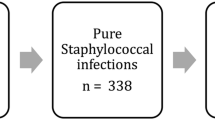Abstract
We describe the results of a retrospective analysis of patients with microbiologically proven infection, who underwent revision TKA between 1994 and 2008. Of the 121 patients included in the study, 61 (50%) were male and 60 (50%) were female. The mean age was 71 (range 42–88) years. The most common organisms identified were Coagulase negative Staphylococcus (CNS) (49%) and Staphylococcus aureus (SA) (13%). The prevalence of CNS appears to be increasing, while that of SA and other organisms is decreasing. Vancomycin and teicoplanin were the most effective antibiotics with overall sensitivity rates of 100% and 96%, respectively. The results of our theoretical model suggest that gentamicin combined with vancomycin is the most effective empirical regimen. Staphylococcal species are the most common organisms encountered in deep infection of the knee. Gentamicin combined with vancomycin offers the most comprehensive protection and potentially allows for infected knee arthoplasties to be treated with a one-stage procedure.





Similar content being viewed by others
References
Wilson MG, Kelley K, Thornhill TS (1990) Infection as a complication of total knee-replacement arthroplasty. Risk factors and treatment in sixty-seven cases. J Bone Joint Surg [Am] 72:878–883
Salvati EA, Robinson RP, Zeno SM, Koslin BL, Brause BD, Wilson PD Jr (1982) Infection rates after 3175 hip and total knee replacements performed with and without a horizontal unidirectional filtered air-flow system. J Bone Joint Surg [Am] 64:525–535
Phillips JE, Crane TP, Noy M, Elliott TSJ, Grimer RJ (2006) The incidence of deep prosthetic infections in a specialist orthopaedic hospital: a 15-year prospective survey. J Bone Joint Surg [Br] 88-B:943–948
Blom AW, Brown J, Taylor AH, Pattison G, Whitehouse S, Bannister GC (2004) Infection after total knee arthroplasty. J Bone Joint Surg [Br] 86:688–691
Gill GS, Mills DM (1991) Long-term follow-up evaluation of 1000 consecutive cemented total knee arthroplasties. Clin Orthop Relat Res 273:66–76
Bengtson S, Knutson K (1991) The infected knee arthroplasty: a 6-year follow-up of 357 cases. Acta Orthop Scand 62:301–311
Rand JA, Fitzgerald RH Jr (1989) Diagnosis and management of the infected total knee arthroplasty. Orthop Clin North Am 20:201–210
Pavoni GL, Giannella M, Falcone M, Scorzolini L, Liberatore M, Carlesimo B, Serra P, Venditti M (2004) Conservative medical therapy of prosthetic joint infections: retrospective analysis of an 8-year experience. Clin Microbiol Infect 10(9):831–837
Dixon P, Parish EN, Cross MJ (2004) Arthroscopic debridement in the treatment of the infected total knee replacement. J Bone Joint Surg [Br] 86-B:39–42
Schoifet SD, Morrey BF (1990) Treatment of infection after total knee arthroplasty by debridement with retention of the components. J Bone Joint Surg [Am] 72-A:1383–1390
Haleem AA, Berry DJ, Hanssen AD (2004) Mid-term to long-term followup of two-stage reimplantation for infected total knee arthroplasty. Clin Orthop Relat Res 428:35–39
Meek RM, Masri BA, Dunlop D, Garbuz DS, Greidanus NV, McGraw R, Duncan CP (2003) Patient satisfaction and functional status after treatment of infection at the site of a total knee arthroplasty with use of the PROSTALAC articulating spacer. J Bone Joint Surg [Am] 85:1888–1892
Hanssen AD (2002) Managing the infected knee: as good as it gets. J Arthroplasty 17(Suppl 1):98–101
Bargiotas K, Wohlrab D, Sewecke JJ, Lavinge G, Demeo PJ, Sotereanos NG (2006) Arthrodesis of the knee with a long intramedullary nail following the failure of a total knee arthroplasty as the result of infection. J Bone Joint Surg [Am] 88(3):553–558
Isiklar Z, Landon G, Tullos H (1994) Amputation after failed total knee arthroplasty. Clin Orthop Relat Res 299:173–178
Barrack RL (1996) Economics of the infected total knee replacement. Orthopedics 19:780–782
Sculco TP (1993) The economic impact of infected total joint arthroplasty. AAOS Instructional Course Lectures 42:349–351
Raad I, Alrahwan A, Rolston K (1998) Staphylococcus epidermidis: emerging resistance and need for alternative agents. Clin Infect Dis 26(5):1182–1187
Davis N, Curry A, Gambhir AK, Panigrahi H, Walker CRC, Wilkins EGL, Worsley MA, Kay PR (1999) Intraoperative bacterial contamination in operations for joint replacement. J Bone Joint Surg [Br] 81-B:886–889
Fulkerson E, Della Valle CJ, Wise B, Walsh M, Preston C, Di Cesare PE (2006) Antibiotic susceptibility of bacteria infecting total joint arthroplasty sites. J Bone Joint Surg [Am] 88:1231–1237
Moran E, Masters S, Berendt AR, Mclardy-Smith P, Byren I, Atkins BL (2007) Guiding empirical antibiotic therapy in orthopaedics: the microbiology of prosthetic joint infection managed by debridement, irrigation and prosthesis retention. J Infect 55:1–7
Rafiq I, Gambhir AK, Wroblewski BM, Kay PR (2006) The microbiology of the infected hip arthroplasty. Int Orthop 30:532–535
Adams K, Couch L, Cierny G, Calhoun J, Mader JT (1992) In vitro and in vivo evaluation of antibiotic diffusion from antibiotic-impregnated polymethylmethacrylate beads. Clin Orthop Relat Res 278:244–252
Kuechle DK, Landon GC, Musher DM, Noble PC (1991) Elution of vancomycin, daptomycin and amikacin from acrylic bone cement. Clin Orthop Relat Res 264:302–308
`Chohfi M, Langlais F, Fourastier J, Minet J, Thomazeau H, Cormier M (1998) Pharmacokinetics, uses and limitations of vancomycin-loaded cement. Int Orthop 22:171–177
Author information
Authors and Affiliations
Corresponding author
Rights and permissions
About this article
Cite this article
Nickinson, R.S.J., Board, T.N., Gambhir, A.K. et al. The microbiology of the infected knee arthroplasty. International Orthopaedics (SICOT) 34, 505–510 (2010). https://doi.org/10.1007/s00264-009-0797-y
Received:
Accepted:
Published:
Issue Date:
DOI: https://doi.org/10.1007/s00264-009-0797-y




